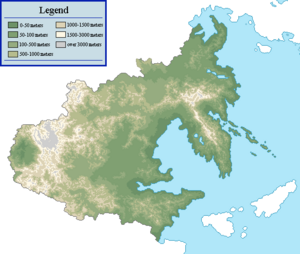Geography of Zhenia
 | |
| Continent | Tarsis |
|---|---|
| Region | Themis |
| Area | |
| • Total | 5,423,777.2 km2 (2,094,132.1 sq mi) |
| • Land | 94.34% |
| • Water | 5.66% |
| Borders | Yinguo |
| Highest point | Mount Changjin 8,782.8 m |
| Lowest point | Lake Sagyeong -87 m |
| Longest river | Taimir River 5,429 km |
| Largest lake | Lake Jinsa 6,507.3 km2 |
| Climate | Generally temperate and continental climate, arid/semi-arid in west, alpine tundra in the central-western mountains; monsoon-influenced temperate climate in the central and east coasts, subtropical in the south |
| Terrain | Mountains in center-west and southwest and along the Danguk Peninsula, plains in the center, hills in the south |
| Natural Resources | arable land, coal, iron ore, bauxite, uranium, petroleum, natural gas, rare-earth minerals, timber |
| Environmental Issues | air pollution, water pollution, desertification, deforestation, soil erosion |
Zhenia is a nation located on the eastern coasts of the continent of Tarsis in Themys, primarily facing the Hanmaric Ocean. Zhenian geography shows great physical diversity, ranging from fertile lowlands and foothills found along most of the Golden Arc area, to the semi-arid basins and mountains to the west. Both due to terrain and climate, a vast majority of the nation's population and agricultural potential are focused in the east, particularly near the Gulf of Danguk.
While Zhenia's northern and southern borders are each defined by the Baekryong and Juleon Rivers respectively, Zhenia's geography is primarily characterized by the existence of the Cheonsan and Mountains, which act as physical boundaries separating western and northern Zhenia from the remainder of the nation respectively. Arid plains, scrubland, plateaus and rocky deserts dominate the landscape west and north of such mountains, while the Taimir River Basin occupies much of what is central Zhenia. The Bukdu Mountains, with the Manho Heights at its northern end, runs through the length of the mostly mountainous Danguk Peninsula, accompanied by smaller, secondary mountain ranges.
Area
Tectonics
Physical regions
General characteristics
Eastern Zhenia (Danguk Peninsula)
Northern Zhenia
Central Zhenia
Southern Zhenia
Western Zhenia
Climate

Zhenia is home to a highly diverse climate, due to tremendous differences in latitude, longitude and altitude throughout its territory. Spanning between the latitude lines of 20.8° and 52.6° N, Zhenia's climate spectrum runs from hot in the south to cold in the northeast and humid in the east along the coastline to dry in the west, resulting in a climate that ranges from tropical in the south, subarctic in the northeast and desert in the west. Climate in much of Zhenia is influenced by seasonal winds and monsoons, bringing in a yearly oscillatory cycle of dry seasons and wet monsoons, in which a bulk of annual precipitation is highly concentrated in certain months of the year. Warm and moist air from the Hanmaric Ocean results in high precipitation and typhoons during the summer season, while the cold and dry continental air from the north dominates the winter season with cold weather and far less precipitation.
Natural disasters
Earthquakes
Volcanic activity
Despite its location near active plate boundaries, Zhenia is home to only a handful of active volcanoes that have been active in the past 300 years, the most notable one being Mount Honghwa in the Haedong Islands. While there have been no life-threatening eruptions within the past 100 years due to the distance of active volcanoes from major populated areas, the most recent major eruption of an active volcano in Zhenia occurred in 1987, during the eruption of Mount Honghwa. The Ministry of the Interior, in tandem with the Ministry of the Environment, has been overseeing volcanic activities of both active and dormant volcanoes throughout the nation since 1974, while all signs of volcanic activity was formally included into the nation's emergency alert network since 1995.
Typhoons
In much of mainland Zhenia and the Danguk Peninsula, a bulk of the annual precipitation is focused in the summer seasons, a considerable portion of which often comes at the form of typhoons, which originate in the West Hanmaric Ocean and make their way westward before turning clockwise to the north to the East Zhenian Sea. While Central and Southern Zhenia tend to be more affected by typhoons in June and July, more typhoons tend to pass through the Danguk Peninsula and the Haedong Islands in August and September due to seasonal variations in wind speeds.
In theory, almost all of Zhenia's coastline can be at risk of typhoons; however, while most typhoons normally affected mainland Zhenia and the areas surrounding the Gulf of Danguk, recent trends since the late 2000s have seen increased frequency of typhoons making way further northeast, increasing the risks of flooding and significant property damage in the area. There have been increased concerns regarding the rise of surface temperature in the West Hanmaric Ocean, as well as varying patterns of temperature oscillation in the Hanmaric Ocean in general, in fear that such factors are contributing to stronger typhoons.
